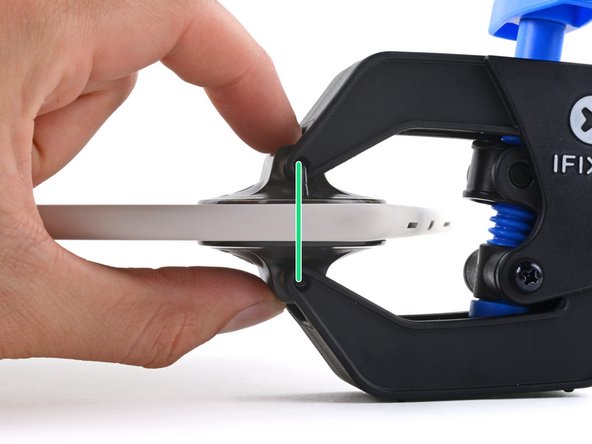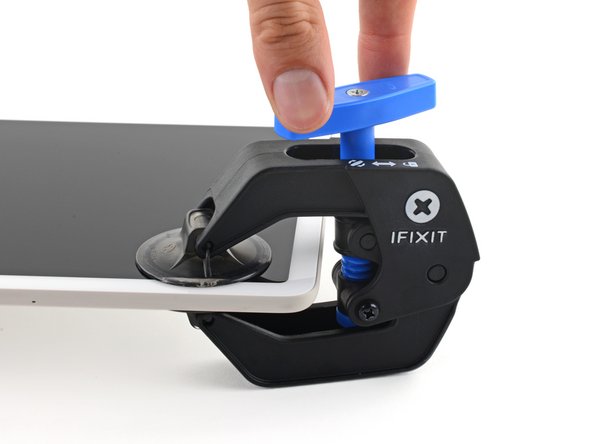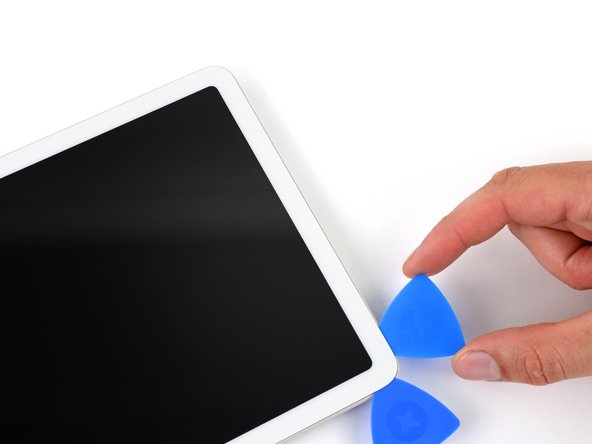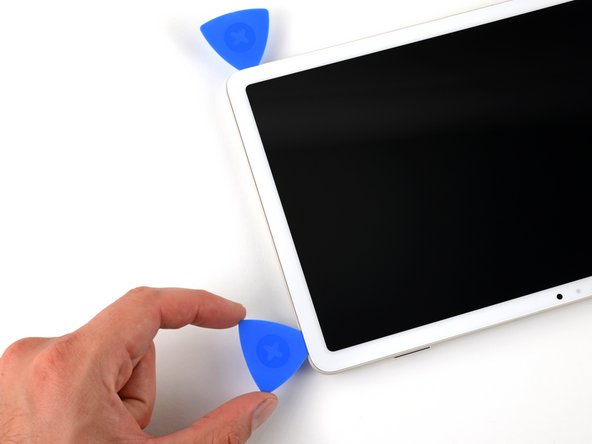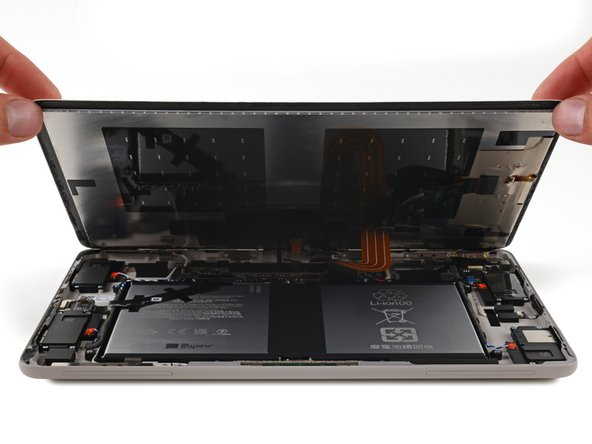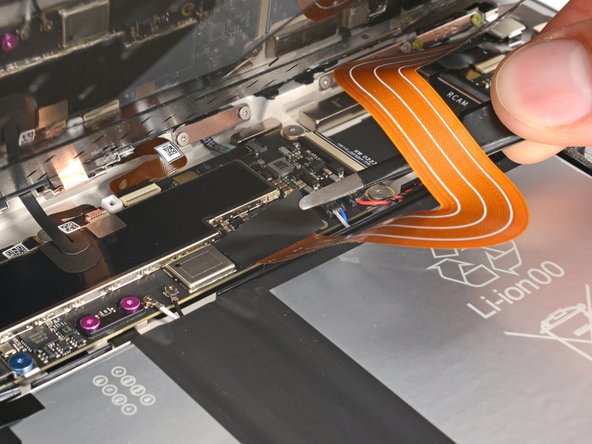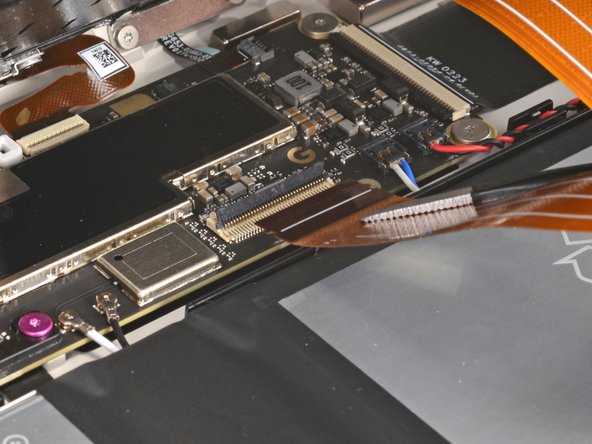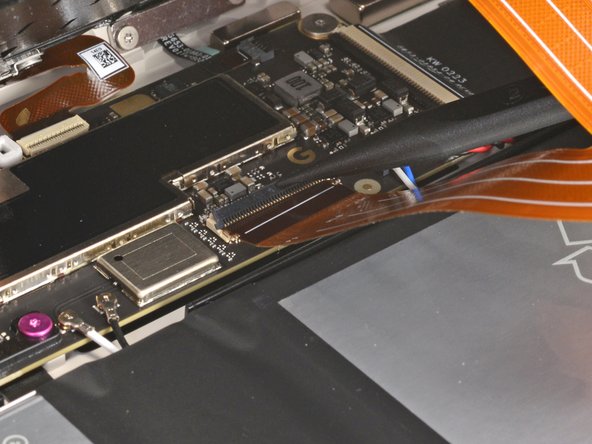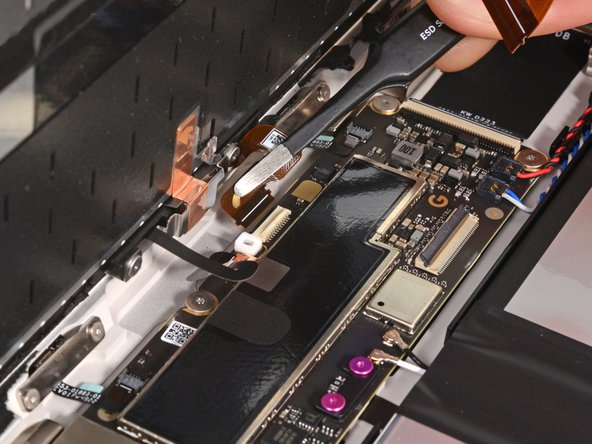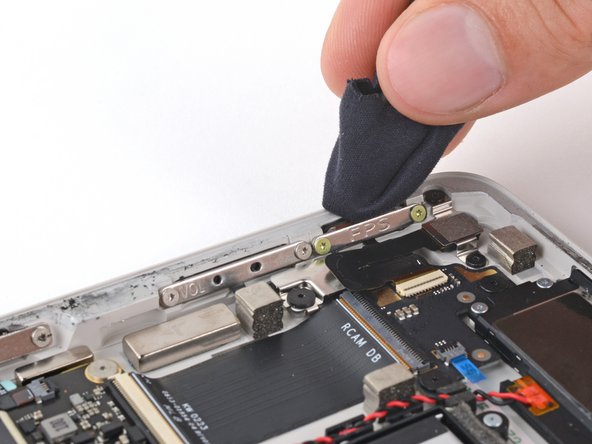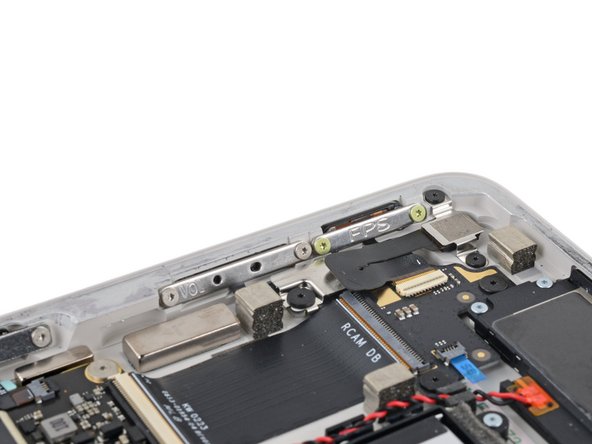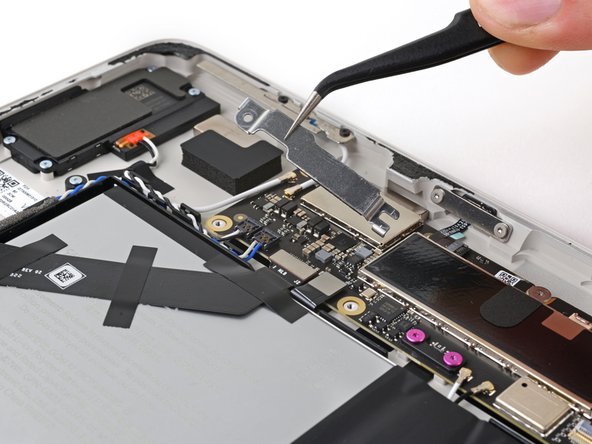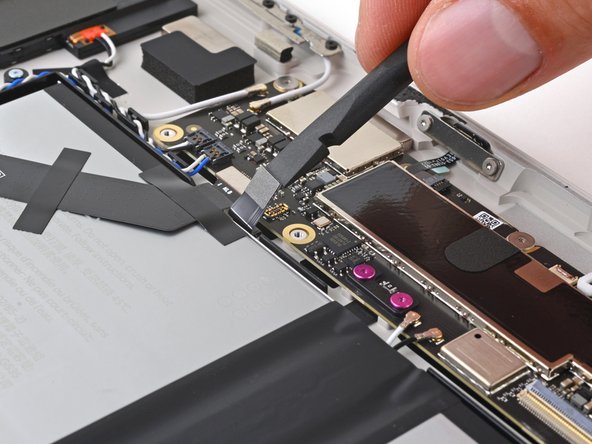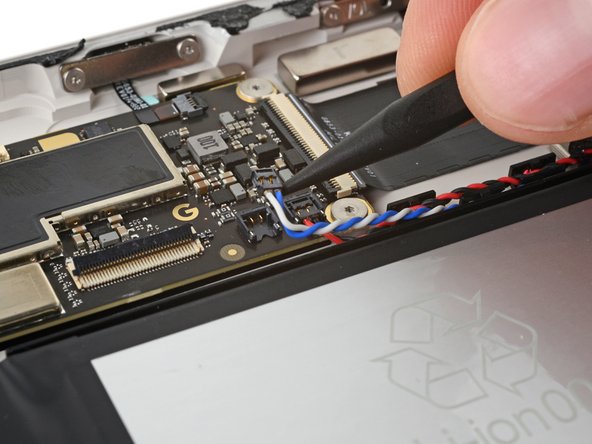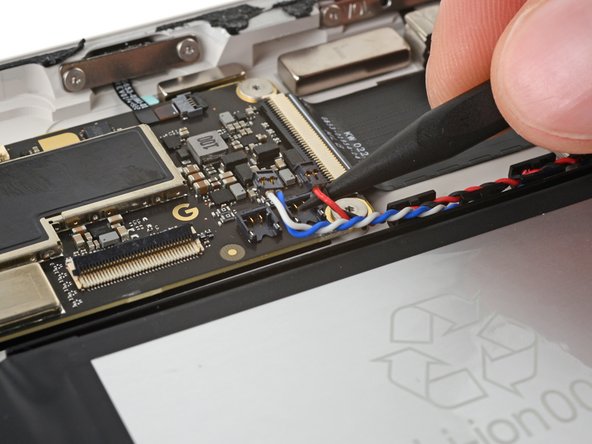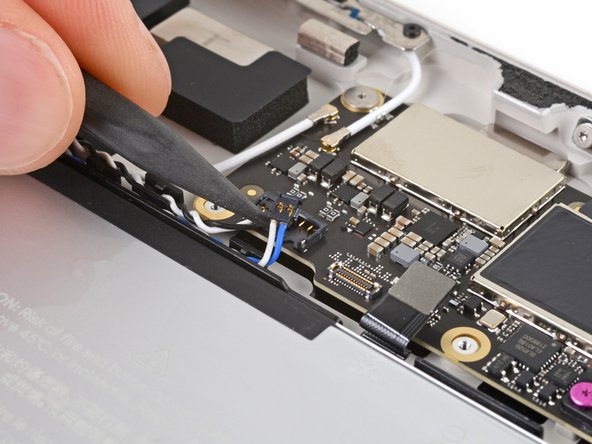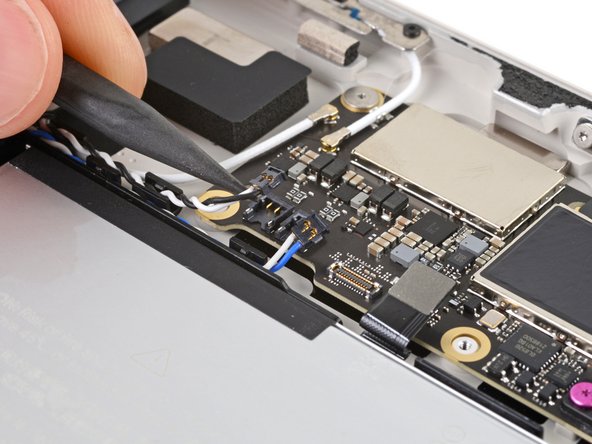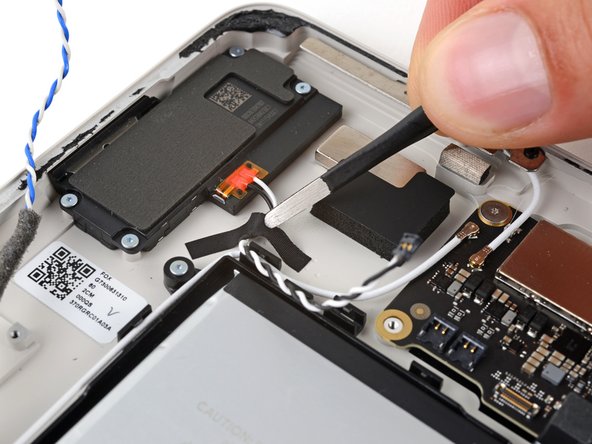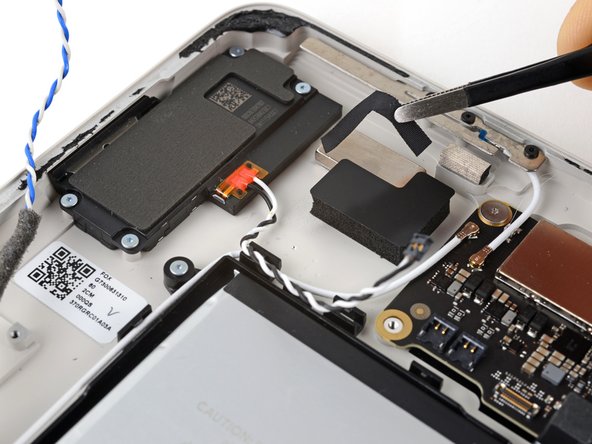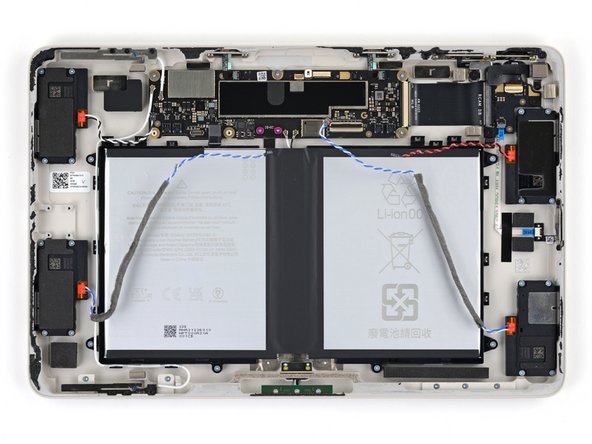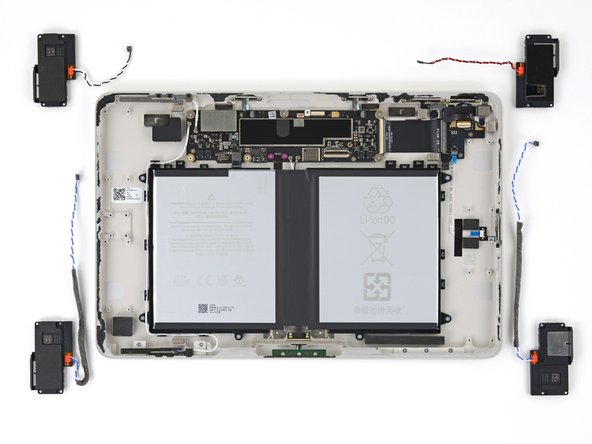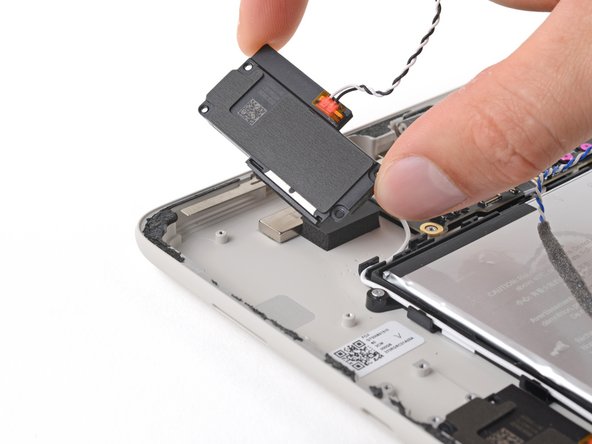Google Pixel Tablet Speakers Replacement
Duration: 45 minutes
Steps: 40 Steps
This repair guide has been crafted with care to help you tackle your tech troubles. For more details on our repair guides, check out schedule a repair.
Welcome to your speaker replacement guide! If your tablet’s audio is giving you the silent treatment, sounding like a broken record, or just plain muffled, it’s time for a speaker swap. This guide will help you replace all four speakers, but feel free to jump in and tackle any one of them as needed. Just a heads up: you’ll want to grab some thin, double-sided tape, like Tesa 61395 Tape, to keep everything snug and secure while you work. If you need help, you can always schedule a repair.
Step 1
Give that battery a little time out and let it totally drain before diving into this repair. A charged battery might just throw a fiery tantrum if it gets damaged.
Press and hold the power button along with the volume up button to pop up that handy power off menu. You’ve got this!
– Disconnect all the cables from your tablet and power it down completely.
Step 2
– Got a nasty crack on your screen? No worries! Just grab some packing tape and lay down overlapping strips over the glass. It’ll protect your fingers and make taking everything apart a breeze!
Step 3
For all the juicy details on mastering the Anti-Clamp, give this guide a whirl!
– Get ready for some fun with the Anti-Clamp! This nifty tool is here to make your opening procedure a breeze. If you’re going a different route, feel free to skip ahead three steps for another method.
– To get things started, pull that blue handle back to unlock the Anti-Clamp’s arms. It’s super easy!
– Carefully slide the arms over the top left corner, with one suction cup sticking to the back cover and the other on the screen. Nice and steady!
– Now, grab something to prop under your tablet so it sits evenly between the Anti-Clamp’s arms. You’re doing great!
– Give those suction cups a squeeze to create some serious suction power.
Step 4
– Give that blue handle a gentle tug forward to lock in those arms. You’ve got this!
– Now, twist that handle clockwise a couple of full spins, or until you see those suction cups stretching out. Keep an eye on them!
– As the cups stretch, make sure they’re standing tall and aligned just right. If they start to wiggle, no worries! Just take off the Anti-Clamp and stick some tape on them for a solid grip.
Step 5
Keep an eye on that tablet temperature—both the screen and battery can get a bit grumpy with too much heat. Let’s keep them cool and happy!
– Grab a hair dryer or heat gun and warm up the top left corner of the screen until you see a little gap form between the glass and the frame.
– Once that gap shows up, carefully slide an opening pick into it.
– Now, gently pull on the suction cup tabs to remove the Anti-Clamp. It should come off smoothly!
Tools Used
Step 6
If you’ve already got an opening pick in place with the Anti-Clamp, feel free to skip ahead by two steps.
You can also give your trusty hair dryer, heat gun, or hot plate a whirl, but make sure to keep an eye on things! We don’t want to turn your screen or battery into a hot mess—just aim for it to be nice and warm to the touch.
– Flip your tablet so the front camera is facing you like it’s ready for a selfie.
– Grab your heated iOpener and give some love to the top left corner of the screen (which is now your bottom right since we did a little flip) for about three minutes.
Tools Used
Step 7
– Grab a suction handle and stick it on the top left corner of the screen, right near the edge.
– Give that handle a solid pull, nice and steady, until you see a little gap open up between the glass and the frame.
– Slide the tip of an opening pick right into that gap.
– Now go ahead and remove the suction handle.
Tools Used
Step 8
The screen is held down with adhesive all around the edges. Keep an eye on these spots as you peel away the sticky stuff:
– The adhesive is thickest along the top, bottom, and left edges—it’s like the super glue of phone repair!
– On the right edge, you’ll find it’s a bit more relaxed with slightly thinner adhesive.
– Keep an eye on the top, just above the front camera, where the adhesive gets super delicate—those tiny cables connecting the screen to the frame are a bit shy, so handle with care!
Step 9
Keep your pick’s adventures limited to 7 mm deep—just about halfway between the pick’s tip and the logo. We want to keep things safe and sound!
– Gently slide your trusty opening pick into the top left corner of the tablet, like you’re making a delightful little pocket.
– Keep that pick in place to stop the adhesive from playing hide and seek!
Step 10
You could also grab a hair dryer, heat gun, or hot plate to help out, but just remember to keep it cool for your screen and battery – we don’t want any meltdowns!
– Warm up that iOpener and place it on the left edge of the screen for a cozy two minutes.
Tools Used
Step 11
Keep your pick under 7 mm deep—think of it as halfway between the tip of your pick and the cool logo!
– Pop a second opening pick into the top left corner of the screen.
– Glide that pick down to the bottom left corner to break free the adhesive holding things down.
– Keep that pick in place to make sure the adhesive doesn’t seal back up on you.
Step 12
Feel free to bring in a hair dryer, a heat gun, or even a hot plate to lend a helping hand! Just remember to keep an eye on it—nobody wants to cause a meltdown for the screen or the battery.
– Take your heated iOpener and gently apply it to the bottom edge of the screen. Keep it there for about two minutes to get everything nice and warm.
Tools Used
Step 13
Keep your pick within a cozy 7 mm depth, which is about halfway between the tip of the pick and the Salvation Repair logo. We want to keep things safe and sound while you work your magic!
If your pick gets a little too cozy with the adhesive, just give it a gentle twist while you slide it out. That should help you break free and keep on repairing!
– Pop in a third opening pick at the bottom left corner—like a little doorstop for your device!
– Gently glide that pick over to the bottom right corner of the screen to break free the adhesive holding it down.
– Keep that pick in place to make sure the adhesive doesn’t decide to throw a reunion party.
Step 14
Feel free to grab a hair dryer, heat gun, or hot plate, but just watch out for overheating that screen or battery. We’re here to keep things cool while you fix it up!
– Warm up that trusty iOpener and place it on the right edge of the screen for a cozy two-minute spa session.
Tools Used
Step 15
Be careful not to insert your pick more than 5 mm along the right edge, or you might end up with a bigger problem than you started with!
For a visual cue, measure about 5 mm from the tip and mark it with a permanent marker. This will help keep things neat and precise!
– Pop a fourth opening pick into the bottom right corner like you’re a seasoned pro.
– Slide that pick smoothly up to the top right corner to break free the right edge adhesive.
– Keep this pick in place to stop that pesky adhesive from sealing up again.
Step 16
When heat is needed, a hair dryer or heat gun can be used, just be cautious not to overheat the screen or battery, as this can cause damage.
– Warm things up a bit! Grab that heated iOpener and let it hang out on the top edge of the screen for a cozy two minutes. You’re doing great!
Tools Used
Step 17
The front camera and sensor are located right in the center of the top edge. Just a friendly heads-up: keep your opening pick no deeper than 3 mm (1/8 in) in this area to avoid any mishaps.
For a handy visual guide, measure 3 mm from the tip and give your pick a little love tap with a permanent marker to mark it.
– To avoid slicing too deep, a simple trick is to place a 6.3 cm (2.5 in) strip of masking tape along the top edge, right over the front camera. This will help guide your cuts and keep things smooth.
Step 18
– Let’s get that fifth opening pick into the top right corner of your screen like it’s a VIP!
– Now slide your pick toward the front camera, and stop when you’re 3 cm (1.25 in) away from it. You’re doing great!
– Gently pull your pick out to about 3 mm (1/8 inch) and slide it past the front camera. Keep it smooth!
– Once your pick is 3 cm past the front camera, go ahead and insert it up to 6 mm deep. Aim for about halfway between the tip and the Salvation Repair logo. Then, slide that pick over to the first one you placed in the top left corner. You’re almost there!
Step 19
Keep that screen angle under 90 degrees, folks! Those front camera and sensor cables are on a tight leash and could snap if you push it too far.
If the screen seems a bit stubborn, take a look around the edges for any sneaky spots where adhesive might be lurking. Use an opening pick to gently slice through those areas.
– Gently grab those bottom corners of the screen and give it a little lift.
– Tilt the screen just enough to peek at the cables that connect it to the frame—like a mini reveal party!
– When it’s time to put everything back together, don’t forget to peel off those adhesive liners from around the screen before you press it snugly into the frame.
Step 20
Having a tough time keeping the screen up? No worries! Just pop the tablet’s dock on the frame to give the screen a little boost, or you could get a buddy to help hold it while you work your magic.
– For the next three steps, keep the screen tilted open with one hand while you work your magic with the other hand.
– Grab your tweezers and gently peel away the black tape from the screen cable connector like a pro.
– As you get ready to put everything back together:
– If the old tape is looking worse for wear, pop in some new tape from your repair kit.
– Now’s the perfect moment to give your tablet a little test run before you seal it up. Power it on and make sure it’s all working smoothly. Don’t forget to power it down again before you finish reassembly.
Tools Used
Step 21
– Gently nudge that little locking flap on the inside edge of the screen cable ZIF connector up with the tip of a spudger or a clean fingernail. You’re doing great!
– Now, with a steady hand, use tweezers or your fingers to pull the screen cable straight out of its cozy socket. Almost there!
Step 22
– Grab your trusty opening pick and gently flip up that tiny locking flap on the edge opposite the cable for the front camera ZIF connector. You’ve got this!
– Next, take your tweezers and confidently pull the cable straight out of its cozy little socket. Easy peasy!
– When putting everything back together, watch out for that cable—it’s a bit of a diva and doesn’t like to bend too much. Use tweezers to guide the connector into its socket while locking that ZIF connector flap in place. You’ve got the skills, just take your time!
Tools Used
Step 24
– Get ready to dive in and gently pop off the screen. You’ve got this!
Step 25
When reusing your screen, make sure to give it a little TLC by removing any old adhesive from both the screen and the frame.
– Get ready to give your frame some TLC before we put it all back together! First up, grab your trusty spudger or a clean fingernail and gently lift an edge of the stubborn leftover adhesive until you can get a good grip.
– With your tweezers or fingers, peel away those pesky large chunks of adhesive from the frame like a pro. We want a clean slate here!
– Keep at it around the entire edge of the frame until all the big pieces are history. You’re doing great!
Step 26
If you’re giving your screen a second chance, take a minute to wipe down its edges and frame to get it squeaky clean.
– Grab a pipette or syringe and fill it up with some strong isopropyl alcohol (over 90%). Now, let’s get to work—apply a few drops right along the edge of the frame!
– Next up, take a microfiber or lint-free cloth, wrap it around the flat end of your trusty spudger, and give that frame a good scrub until it shines. Don’t hesitate to add more isopropyl alcohol as you go along for a sparkling finish!
Tools Used
Step 27
The Pixel Tablet uses Torx Plus screws, but no worries—standard Torx bits will do the job in a pinch! Just remember to keep a steady downward pressure to avoid stripping the screws.
If you’re using standard Torx bits, a T3 will be your best bet. If it feels a bit too loose, a T4 bit might be just what you need.
– Grab your trusty Torx Plus 3IP driver and get ready to unscrew those two 2.6 mm screws holding down the battery, USB-C, and speakers connectors cover. You’ve got this!
– Now, gently lift off the cover and reveal the magic inside.
Step 28
To reconnect a press connector, simply line it up with its socket and give it a gentle nudge down on one side until you hear that satisfying click. Then, do the same on the other side. You’re doing great!
– Carefully slide the flat end of your spudger under the battery connector and gently lift to disconnect it. You’re almost there!
Tools Used
Step 29
Connecting the screen cable while the battery is plugged in could cause a short circuit and might just ignite a fire hazard. So let’s keep our sparks to a minimum, okay?
– Let’s make sure you reconnect that screen and battery properly during reassembly!
– Prop up the bottom edge of the tablet on a box or something similar. Tilt the screen open and lean it back so it’s at a nice angle of 90 degrees.
– Reconnect the small front sensor cable ZIF connector—let’s get that back in place!
– Now, it’s time to reconnect the large screen cable ZIF connector.
– Don’t forget to reconnect the battery press connector.
– Grab your Torx Plus 3IP driver and install the two 2.6 mm screws to secure the connector cover.
– You’re doing great! Keep going and continue reassembling with those cables connected.
Step 30
– Grab your trusty spudger and use its flat end to gently pry up and disconnect that USB-C port press connector. You’ve got this!
Tools Used
Step 31
Watch out for that battery! Keep your tool away so we don’t have any shocking surprises during this step.
– Grab some blunt nose tweezers or just your fingers and gently peel up those three strips of tape holding the USB-C port cable snugly against the battery. You’ve got this!
– When you’re putting everything back together, feel free to reuse those tape strips if they’re still looking good. If they’ve seen better days, no worries! Just cut a few thin strips of electrical tape to keep that cable securely attached to the battery.
Tools Used
Step 32
– Grab your trusty Torx Plus 3IP driver and get ready to tackle those four 3.2 mm screws that are holding the USB-C port in place. Let’s get this done!
Step 33
– Gently wiggle the USB-C port free from its snug little home in the frame and take it out with care.
Step 34
Gently lift straight up on the neck of the cables, aiming for the area closest to the connector head. You’ve got this!
– Grab your trusty spudger and gently lift up to disconnect that blue and white speaker cable connector from the right side of the logic board. You’ve got this!
– Now, it’s time to say goodbye to the red and black speaker cable connector. Disconnect it with confidence!
Tools Used
Step 35
– Gently slide the blue and white speaker cables out from their cozy clips that line the top and right side of the battery tray.
– Carefully detach the red and black speaker cables from their clips resting along the top of the battery tray.
Step 36
Gently pry straight up on the cable’s neck, getting as close as possible to the connector’s head. This will help you avoid causing any damage to the surrounding area.
– Grab your trusty spudger and gently pry up that blue and white speaker cable connector on the left side of the logic board. Disconnect it with a little finesse!
– Now, let’s tackle the black and white speaker cable connector. Time to disconnect that one too!
Tools Used
Step 37
– Gently wiggle the blue and white speaker cable free from their cozy clips along the top and left edges of the battery tray.
– Now, let’s give that black and white speaker cable a little tug to release it from its snug home along the top edge of the battery tray.
Step 38
– Grab those blunt nose tweezers or just use your fingers to gently lift and peel away the tape holding the black and white speaker cable to the frame. Easy peasy!
– When you’re putting everything back together, feel free to reuse that tape if it’s still in good shape. If it looks like it’s seen better days, just cut a little piece of electrical tape to keep those cables snug against the frame.
Tools Used
Step 39
For those using standard Torx bits, grab a T3 Torx for these screws—it’s your best buddy! If it feels a bit snug, don’t worry; a T2 Torx bit will do the trick.
– Grab your trusty Torx Plus 2IP driver and tackle those sixteen 2.7 mm screws holding the four speakers in place. You’ve got this!
Step 40
– Time to put your device back together! Just retrace your steps and follow these instructions backward.
– Got some e-waste? Give it a new home by taking it to anR2 or e-Stewards certified recycler.
– If things didn’t go quite as smoothly as planned, don’t sweat it! A little basic troubleshooting might do the trick, or feel free to reach out to our awesome Answers community for a hand.
–






